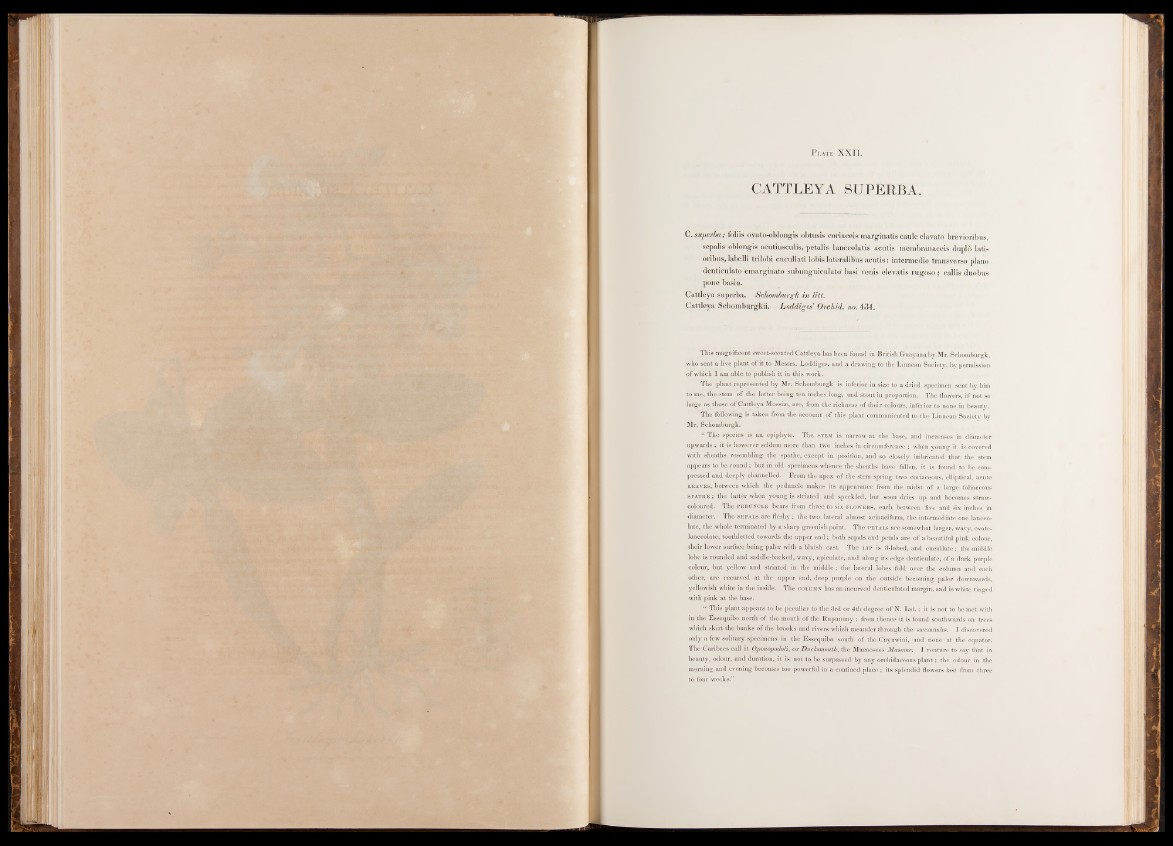
CATTLEYA SUPERBA.
C. superba; foliis ovato-oblongis obtusis coriaceis marginatis caule clavato brevioribus,
sepalis oblongis acutiusculis, petalis lanceolatis acutis membranaceis dupld lati-
oribus, Iabelli trilobi clicullati lobis lateralibus acutis: intermedio transverso piano
denticulato eraarginato subunguiculato basi venis elevatis rugoso; callis duobus
pone basin.
Cattleya superba. Schomburgh in litt.
Cattleya Schomburgkii. Loddiges’ Orchid, no. 434.
This magnificent sweet-scented Cattleya has been found .in British Guayana.by.Mr. Schomburgk,
who sent a live plant of it to Messrs. Loddiges, and a drawing to the Linnean Society, by permission
of which I am able to publish it in this work.
The plant represented by Mr. Schomburgk is inferior in size to a dried specimen sent by him
to me, the stem of the latter being ten inches long, and stout in proportion. The flowers, if not so
large as those of Cattleya Mossiae, are, from the richness of their colours, inferior ,to none in beauty.
The following is taken from the account of this plant communicated to the Linnean Society by
Mr. Schomburgk.
“ T h e species is an epiphyte. The s t em is narrow at the base, and increases in diameter
upwards ; it is however seldom more than two inches in circumference ; when young it is covered
with sheaths resembling the spathe, except in position, and so closely imbricated that the stem
appears to be round; but in old specimens whence the sheaths have fallen, it is found to be compressed
and deeply channelled. From the apex of the stem spring two coriaceous, elliptical, acute
l e a v e s , between which the peduncle makes its appearance from the midst of a large foliaceous
SPATHE; the latter when young is striated and speckled, but soon dries up and becomes straw-
coloured. The p e d u n c l e bears from three to six f l o w e r s , each between five and six inches in
diameter. The s e p a l s are fleshy ; the two lateral almost acinaciform, the intermediate one lanceolate,
the whole terminated by a sharp greenish point. The p e t a l s are somewhat larger, wavy, ovate-
lanceolate, toothletted towards the upper end; both sepals and petals are of a beautiful pink colour,
their lower surface being paler with a bluish cast. The l i p is 3-lobed, and cucullate ; the middle
lobe is rounded and saddle-backed, wavy, apiculate, and along its edge denticulate, of a dark purple
colour, but yellow and striated in the middle; the lateral lobes fold over the column and each
other, are recurved at the upper end, deep purple on the outside becoming paler downwards,
yellowish white in the inside. The c o l u m n has an incurved denticulated margin, and is white tinged
with pink at the base.
“ This plant appears to be peculiar to the 3rd or 4th degree of N. Lat.; it is not to be met with
in the Essequibo north of the mouth of the Rupununy ; from thence it is found southwards on trees
which skirt the banks of the brooks and rivers which meander through the savannahs. I discovered
only a few solitary specimens in the Essequibo south of the Cayuwini, and none at the equator.
The Caribees call it Oponopodoli, or Ducksmouth, the Macoosees Masame. I venture to say that in
beauty, odour, and duration, it is not to be surpassed by any orchidaceous plant; the odour in the
morning and evening becomes too powerful in a confined place; its splendid flowers last from three
to four weeks.”